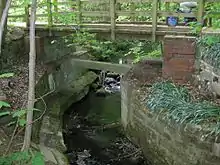Meanwood Beck
The Meanwood Beck is a stream in West Yorkshire, England, which flows southwards through Adel, Meanwood and Sheepscar into the River Aire in central Leeds. Different portions of the same watercourse have been referred to as Adel Beck, Carr Beck, Lady Beck, Mabgate Beck, Sheepscar Beck, Timble Beck or Wortley Beck.[1] The Meanwood Valley Trail footpath follows the line of the beck for much of its course.





The ultimate source of the water is Otley Chevin and the Marsh Beck feeds into what is now the Wildfowl Lake (formerly the Black Hill Dam)[2] in Golden Acre Park.[3] According to Ordnance Survey, it is called Adel Beck from the outflow of the lake down to the A6120 Ring Road, then beyond this is the Meanwood Beck.[4] John Cossins' 1775 plan of Leeds shows Sheepscar Beck as essentially the East limits of the town at the time, Adel being some distance away and Meanwood still a wood.[5] It became the Lady Beck from Quarry Hill to the River Aire.[3]
It is of historical importance because it deposited silt into the River Aire. Along with the Hol Beck[6] doing the same from the South-West nearby it led to a fording place and a small community which eventually grew into the town of Leeds.[7]
The beck was previously a source of water for the village of Headingley and two of its earliest bridges led straight to it. The beck carries a much reduced volume of water over recent years as water is collected instead into the many drains in the centre of one of Britain's largest cities.
Meanwood Beck runs through Meanwood Park and Woodhouse Ridge. It provides water and drainage for Meanwood Valley Urban Farm.
In the 16th to 18th centuries it provided power for corn mills.[8] In the 19th century it supplied water for a chemical works and tanneries,[8] one of which, Sugarwell Court, is now a university hall of residence.
The Beck suffered a serious pollution incident on 29 March 1999 when an oil tank at the University of Leeds' Bodington Hall was overfilled and 10,000 litres of oil flowed into the beck.[9] It is also a habitat for the indigenous European crayfish, which is currently threatened in the UK by a plague carried by the Signal crayfish introduced from America. As well as the crayfish there is also bull head fish present which can be found easily with a net and a pair of waders; they generally are located on the stream bed in the mud and silt.
References
- Leeds Mercury 19 February 1866 p4 "The Leeds Improvement of Becks Bill"
- Golden Acre Park - A brief History
- Leodis Cross Stamford Street, Sheepscar Beck
- Ordnance Survey (1996) Street Atlas of West Yorkshire ISBN 0-319-00843-6
- Brian Godward (2004) The Changing Face of Leeds (Sutton Publishing, Stroud) ISBN 0-7509-3413-1
- Leodis Hol Beck
- W. R. Mitchell (2000) A History of Leeds Phillimore, West Sussex, ISBN 1 86077 130 0
- Meanwood Valley Urban Farm History
- McDonald, Professor Adrian. "An Appraisal of the Oil Spill that occurred at Bodington Hall on 29th March 1999". University of Leeds. Archived from the original on 2 April 2015. Retrieved 27 April 2015.
External links
| Wikimedia Commons has media related to Meanwood Beck. |